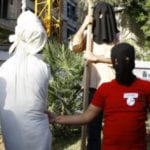 Food
Food  Food
Food  History
History 10 Odd Things Colonial Americans Kept at Home
 Weird Stuff
Weird Stuff 10 Superstitious Beliefs That Once Consumed Entire Cultures
 History
History 10 Bizarre Friendly Fire Incidents in Military History
 Technology
Technology 10 Modern Technologies That Accidentally Imitate Ancient Magic
 Mysteries
Mysteries 10 Mysteries of the Human Genome
 Weird Stuff
Weird Stuff 10 Things So Rare They’ve Only Been Found Once
 History
History 10 Legends Whose Last Moments Undid Their Glory
 Health
Health 10 Futuristic Ideas to Treat Common Medical Problems
 Weird Stuff
Weird Stuff Ten Surreal Attempts to Reverse Baldness
 Food
Food 10 Everyday Foods You Didn’t Know Were Invented by the U.S. Military
 History
History 10 Odd Things Colonial Americans Kept at Home
 Weird Stuff
Weird Stuff 10 Superstitious Beliefs That Once Consumed Entire Cultures
Who's Behind Listverse?

Jamie Frater
Head Editor
Jamie founded Listverse due to an insatiable desire to share fascinating, obscure, and bizarre facts. He has been a guest speaker on numerous national radio and television stations and is a five time published author.
More About Us History
History 10 Bizarre Friendly Fire Incidents in Military History
 Technology
Technology 10 Modern Technologies That Accidentally Imitate Ancient Magic
 Mysteries
Mysteries 10 Mysteries of the Human Genome
 Weird Stuff
Weird Stuff 10 Things So Rare They’ve Only Been Found Once
 History
History 10 Legends Whose Last Moments Undid Their Glory
 Health
Health 10 Futuristic Ideas to Treat Common Medical Problems
 Weird Stuff
Weird Stuff Ten Surreal Attempts to Reverse Baldness
10 Counterintuitive Facts About Modern Terrorism
Note: This list was written on November 12 and was slated for publication on November 14. Following the tragic events in Paris on November 13, we have updated the article accordingly.
Since 9/11, no bogeyman has loomed quite as large in the Western psyche as the specter of terrorism. According to Gallup, over half of all Americans worry “a great deal” about a terror attack while nearly one-third believe the government is incapable of protecting them from one. Hardly a day goes by without a reference to extremism on the news.
Yet for all of this, the mental picture we have of terrorism might not be completely accurate. In fact, many of us harbor serious misconceptions about what modern terrorism really looks like.
10 Some Of The World’s Biggest Terror Groups Aren’t Connected To Islam
In the history of terrorism, probably no group has ever been as big or well funded as ISIS. The caliphate is the richest terror group on Earth. Hezbollah, another group of Islamist extremists, is the second-richest. But not every major exporter of terror is connected to Islam. Some aren’t influenced by religion at all.
Chief among them is the Revolutionary Armed Forces of Colombia (FARC). Officially designated a terrorist organization by the US, the group is a Marxist-Leninist outfit that considers itself atheist. In November 2014, Forbes Israel estimated that it was the third-richest terror group in the world, controlling nearly 30 percent of Colombia and able to call on thousands of recruits.
This makes FARC a bigger organization than either Al-Qaeda or Boko Haram, and FARC isn’t even at its peak. In the early 2000s, FARC was nearly three times the size it is now and was kidnapping a jaw-dropping 3,000 people a year.
Remember Joseph Kony, star of Invisible Children’s viral video, Kony 2012? His Lord’s Resistance Army is still going strong in the Central African Republic, Democratic Republic of Congo, and southern Sudan. Placed on a State Department terrorist exclusion list in 2001, the Christian rebel group has killed up to 100,000 people since 1987, making it deadlier than Boko Haram.
In Japan, the successor group to creepy cult Aum Shinrikyo, which killed 12 people and injured 5,500 in a 1995 nerve gas attack on the Tokyo subway, still has an active membership of around 1,300 and is recruiting more every year. For as much as Islam often seems to be synonymous with “terror,” the truth is that some of the world’s biggest groups don’t give two hoots about Allah.
9 Most Victims Of Terrorism Don’t Live In The West
When we’re glued to the screen watching events unfold like they did in Paris, it can seem like we’re under siege. Throw in 9/11, 7/7, and the Madrid train bombings, and it’s easy to assume that the target of the world’s terrorists is the freedom-embracing West.
The reality is that the West suffers few terror attacks compared to certain areas in the rest of the world. Between 2004 and 2013, the US was attacked 131 times, with 20 attacks causing fatalities. France was attacked 47 times. However, Iraq suffered 12,000 terror attacks, 8,000 of which were deadly.
In the time period studied, about half of all terror attacks and 60 percent of fatalities from those attacks occurred in just three countries: Iraq, Pakistan, and Afghanistan. Next in line are India, Nigeria, Somalia, Yemen, Syria, Sri Lanka, and Thailand.
This isn’t to downplay the tragedy of any attacks that have hit the West. It goes without saying that the Paris attacks and 9/11 attacks were truly horrific and affected millions of lives. But the vast majority of terrorism’s victims are living in the Middle East or Asia, not the US or Europe.
8 Much Of European Terrorism Is Related To Separatism
The Charlie Hebdo shootings in Paris were the biggest terror attack to hit Europe since Anders Breivik killed 77 people in Norway. The November 13 attacks easily passed up both of those events in terms of casualties. But the picture in Europe is far from as black-and-white as this suggests. Rather than being a straightforward mix of Islamist and far-right attacks, terrorist attacks in Europe are usually tied to nationalism.
In 2014, over half of all European terror attacks were related not to religion or right-wing extremism but to Irish Republicanism. Of the 201 attacks across the continent reported by Europol that year, 109 took place in Northern Ireland—accounting for every single attack suffered by the UK. Nationalist or separatist movements were also the primary motivators for terrorism elsewhere. France’s FLNC, which wants the island of Corsica to become an independent state, launched multiple rocket attacks against French police stations in 2013. In 2015, five Macedonian policemen were killed in clashes with nationalist Albanian terrorists.
This is not at all to say that separatism can be blamed for all of Europe’s woes. Left-wing terror has also reared its ugly head in the last two years. In Greece, Marxists murdered two political opponents in 2013 while Italian anarchists sent out multiple letter bombs. Some attacks have even been related to specific issues. In France, a group of radical vintners bombed a local office of the Socialist Party over grievances related to wine production. With ISIS claiming the November 13 attacks, they’ve put themselves into the European terror picture, but there are other groups on the scene as well.
7 Homegrown Terrorists Kill More Americans Than Jihadists

Thanks to 9/11, there’s no doubt that jihadism is the largest mass killer of Americans in terrorist history. In the 14 years since then, Islamic extremists claimed a further 26 lives, most dramatically during the Boston Marathon. But jihadism isn’t the deadliest source of extremism in modern America. During the same period, homegrown terrorists killed twice as many Americans as jihadism.
Post-9/11, 48 US citizens have lost their lives to right-wing extremism. In 2012, for example, neo-Nazi Wade Michael Page attacked a Sikh temple, killing six and seriously wounding three others. In June 2015, Dylann Roof killed nine people when he opened fire in a church in Charleston. Members of the antitax Sovereign Citizens Movement have now murdered so many police officers that the FBI considers them a significant terrorist threat.
Some incidents have been even more dramatic. In 2010, Andrew Joseph Stack flew a light aircraft into an IRS office in a suicide attack, killing himself and one agent and injuring 13 others. As a direct result of actions like these, many police departments now consider right-wing terror a major threat. A 2015 survey of 382 US police and sheriffs’ departments found that 74 percent listed antigovernment violence as the biggest threat in their jurisdiction, compared to 39 percent for “Al-Qaeda–inspired” violence.
6 Left-Wing Terrorists Commit More Nonlethal Attacks Than Any Others
Left-wing values are rarely associated with modern American terrorism. In the 1970s, groups like Weather Underground bombed the US State Department building. Today, left-wing terror is so rare that people write articles wondering where the heck it went.
The answer is that it didn’t go anywhere. In the first decade of the 21st century, the group that carried out the most attacks on American soil wasn’t Al-Qaeda or some far-right movement. It was the ecoterrorist organization Earth Liberation Front (ELF).
Between 2001 and 2011, the group was responsible for 50 separate attacks—more than all other active terror groups combined. The attacks usually involved incendiary bombs that started out-of-control fires, causing millions of dollars of damage. ELF attacks claimed zero lives because the group deliberately tried to avoid fatalities. However, the sheer number of their actions got them added to the FBI’s terrorism watch list.
The only other group to launch anywhere near as many attacks as ELF was the Animal Liberation Front, a related group with a similar track record of nonfatal firebombings. Taken together, their actions marked a renaissance in American left-wing terror.
5 US Terrorism Is Rarely Carried Out By Organized Groups
Al-Qaeda, ISIS, FARC—the annals of terrorism are filled with names of groups that inspire chills. Yet acts of terrorism in the US are rarely carried out by organizations. According to data from the Southern Poverty Law Center (SPLC), nearly every domestic terror incident is the work of lone wolves.
In a study of 60 separate attacks, the SPLC found that nearly 75 percent were plotted and executed by a single person with no known accomplices. When they widened their definition of “lone wolf” to include two people with no outside help, it covered 90 percent of all incidents.
This model of “leaderless resistance” was dreamed up in the late 1980s and early 1990s to ensure that the government couldn’t track wannabe bombers. After Oklahoma City bomber Timothy McVeigh killed 168 people with only one accomplice, actions taken by lone wolves skyrocketed. Between 1995 and 2011, they accounted for one-third of all attacks, with the number of lone wolves increasing in later years (which is why the SPLC study shows a much higher percentage of these attacks after 2009). At this point, active groups in the US are nearly a thing of the past.
4 The Frequency Of Attacks In The US Is Declining
In terms of number of attacks, the high point for terrorism on US soil was 1970 with over 450 recorded incidents. It was the year that the Weather Underground was at its height, Puerto Rican separatism was in full swing, and the Jewish Defense League was bombing offices. No other year has had close to as many attacks in the US. In fact, terrorism in general has been in steep decline.
Although 1970 was an outlier, the 1970s saw a lot of attacks, with at least 50 per year. By the 1990s, the number of incidents only occasionally peaked above that number. Fast-forward to the present and annual terror attacks are closer to zero than they are to 50.
In short, the number of terrorist incidents in the US is dropping even as we feel we’re hearing more about them. Fatal attacks also peaked in the early 1970s. However, mass-casualty events like 9/11 mean that the total number of people killed per year was at its highest in the late 1990s and early 2000s.
3 Studies Show Terrorism Doesn’t Work
Besides the falling frequency of attacks, there’s another fact that may give us a crumb of comfort regarding terrorism. Studies have shown that it almost never works. Instead of giving the terrorists what they want, even in a diluted form, indiscriminate attacks against civilians usually do nothing but undermine the terrorists’ cause.
In a 2009 study from George Mason University, an analysis of 457 terrorist campaigns since 1968 found that no extremist groups succeeded in conquering a state and 94 percent of these groups failed to achieve even one of their stated goals.
Obviously, the study is somewhat out-of-date. We might reasonably suggest that ISIS has bucked the trend and succeeded in carving out a semi-functioning, barbaric state in the Middle East.
But the general point still stands. Despite the IRA’s decades of fighting, Northern Ireland is still a part of Britain. For all their bombings and shootings, right-wing militia groups have failed to spark a revolution or bring down the US government. Even FARC, which arguably came close to overthrowing the Colombian government in the late 1990s, is now thinking about disarming. Rather than being a means to an end, terrorism generally brings its practitioners no closer to their goals.
2 Spreading Religion Or Ideology Is Only Part Of It
When trying to understand why terrorists kill innocent people, there are two basic schools of thought. One is that terrorists are simply evil and take joy in hurting people. The other is that terrorists are trying to spread an ideology or religion through violent means. While this is undoubtedly true, studies show that it’s actually a much smaller part of the terrorist mind-set than you’d think. Most terrorists are motivated by strangely petty reasons.
At Ohio State University, a study of 52 Islamic extremists who targeted the US found that the overwhelming motive was a desire for revenge. Rather than having religious goals, most terrorists wanted to punish America for supporting Israel or were simply angry about the wars in Afghanistan or Iraq.
A University of Michigan study went even further. It claimed that most terrorists, who are typically young men, signed up because they were looking for adventure, camaraderie, status, and women.
This isn’t to downplay the seriousness of terrorism or the importance of understanding a group’s stated goals. Instead, it suggests that our understanding of terrorism’s aims should take into account the larger historical picture and the motivations of individuals within terrorist organizations.
1 9/11 Isn’t The Biggest Attack Ever Attempted

The 9/11 attacks are unparalleled in modern history in terms of loss of life, injuries sustained, economic damage, and the scars it left on a nation. Nearly 3,000 people died, and those who were at Ground Zero may still be dying today from related cancers. Yet other planned attacks would probably have been worse than 9/11 if they had succeeded.
On American soil alone, at least one attack came close to dwarfing the impact of 9/11. On April 22, 1997, four KKK members were arrested for plotting to blow up a gas refinery near Fort Worth, Texas. Authorities later estimated the attack would have killed up to 30,000 people, almost 10 times the number who died on 9/11. It was stopped because the local Klan leader got cold feet and went to the FBI.
Elsewhere, other insanely dangerous attacks have been foiled at the last minute. In 1993, Japan’s Aum Shinrikyo cult released a cloud of anthrax over Tokyo, endangering nearly 7,000 residents. It was only by a stroke of luck that the cult accidentally acquired and released a vaccine strain that was harmless to humans.
Two years later, the group twice tried to detonate cyanide bombs on the Tokyo underground. Authorities claimed that a single successful explosion could have killed 10,000 people. As bad as the history of terrorism may seem, it’s chilling to think that it could be even worse.








